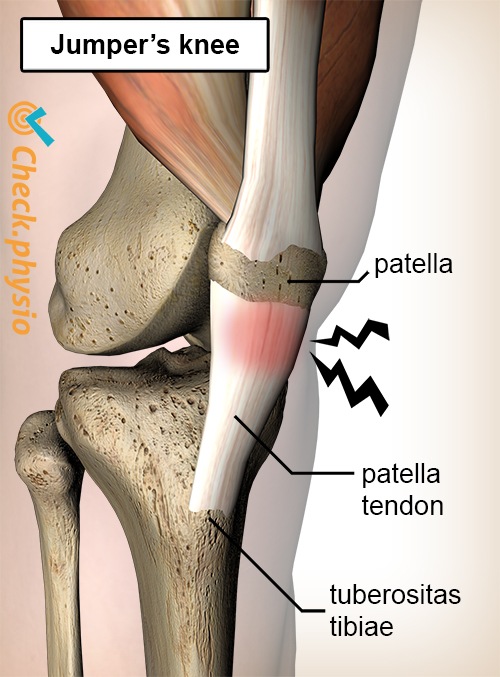- Conditions
- Jumper's knee
Jumper's knee Apexitis patellae / tendinosis of the patellar tendon
Introduction
Jumper's knee gets its name from the fact that the condition is very common with people who play sports that involve a lot of jumping. The symptoms are located around the patellar tendon on the front of the knee.
Jumper's knee is common in sports where (explosive) jumping plays an important part. Volleyball and basketball are good examples of this.

Description of condition
The patellar tendon runs from the base of the knee cap (patella) to the front of the upper part of the shin bone (the tuberositas tibiae). With jumper's knee, the tendon is affected at the point where it attaches to the patella. The tendon may be inflamed (tendinitis), or its quality and structure may deteriorate (tendinosis).
Cause and history
The symptoms develop gradually and are not preceded by any trauma.
Signs & symptoms
The pain is located mainly below the point of attachment of the patellar tendon to the patella. Movements during which the legs are extended explosively (as with jumping) can provoke the symptoms. The symptoms may occur during and after exercise. In severe cases, the pain may even be felt during normal daily activities. For example, when walking up steps or driving a car.
Pressing on the point of attachment of the patellar tendon is painful and sometimes localized swelling is visible. The inflammation is limited to the patellar tendon and is not seen in the rest of the knee joint - unless another injury of the knee is also involved.
Diagnosis
The diagnosis can usually be made by the physiotherapist with reasonable certainty. The patellar tendon can be imaged quite accurately using ultrasound or an MRI scan.
Treatment and recovery
Good results have been obtained with controlled eccentric strength training of the quadriceps muscle (the muscle that extends the knee). Eccentric strength training has a beneficial effect on the quality and tensile force of the tendon.
Exercises
Follow the specially compiled exercise program here with exercises for a jumper`s knee.
More info
You can check your symptoms using the online physiotherapy check or make an appointment with a physiotherapy practice in your locality.
References
Nugteren, K. van & Winkel, D. (2006) Onderzoek en behandeling van peesaandoeningen - tendinose Houten: Bohn Stafleu van Loghum.
Verhaar, J.A.N. & Linden, A.J. van der (2005) Orthopedie Houten: Bohn Stafleu van Loghum.
